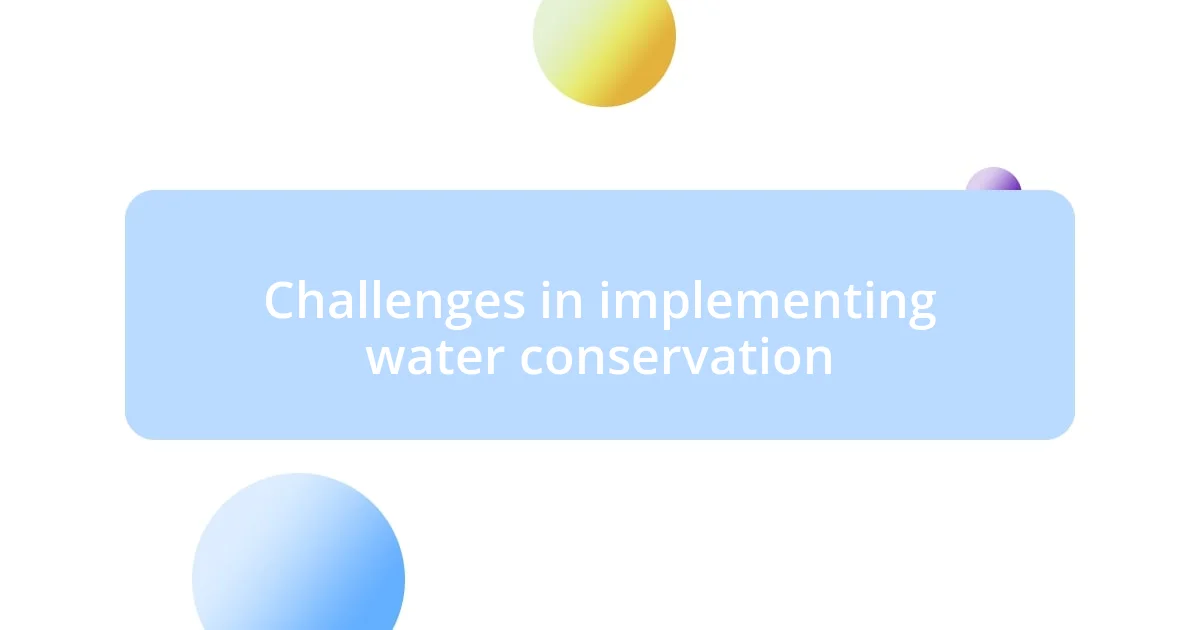Key takeaways:
- Water conservation principles revolve around efficiency, reuse, and sustainable sourcing, highlighting the importance of thoughtful design choices in preserving water resources.
- Implementing innovative technologies such as smart irrigation systems and greywater recycling can significantly reduce water consumption and promote environmental stewardship.
- Challenges in water conservation include regulatory barriers, initial costs for technologies, and the need for greater public awareness to encourage sustainable practices in communities.

Understanding water conservation principles
Water conservation is all about understanding the delicate balance of preserving this precious resource while meeting our needs. I still remember a project I worked on where we aimed to reduce water usage in a community park. By incorporating efficient irrigation systems and choosing native plants, we not only saved water but also created an inviting natural habitat. Isn’t it incredible how small design decisions can lead to significant conservation outcomes?
In my experience, the principles of water conservation hinge on three main ideas: efficiency, reuse, and sustainable sourcing. I once visited a home that featured a rainwater harvesting system, which completely changed my perspective on residential water use. It made me wonder—how often do we really consider where our water is coming from and how we can utilize every drop wisely?
Moreover, an essential tenet of water conservation is considering the entire lifecycle of the materials we use in design. I was involved in a project that focused on using permeable materials for driveways, allowing rainwater to seep into the ground rather than run off. This not only reduced erosion but also replenished groundwater supplies. Have you thought about how the materials in your environment can actively contribute to water conservation? It’s a compelling realization that every element of design plays a role in nurturing our water sources.

Strategies for water-efficient design
Incorporating water-efficient designs begins with understanding how our decisions impact water usage. I recall a school project where we implemented dual-flush toilets and low-flow faucets. The joy of noticing a tangible decline in water bills while still maintaining comfort in the facilities was truly satisfying. It’s remarkable how thoughtful choices can transform not only the functionality of a space but also its environmental footprint.
Here are some strategies to consider for water-efficient design:
- Native Plant Selection: Use plants adapted to local conditions, reducing the need for irrigation.
- Rainwater Harvesting: Install systems to collect and use rainwater for irrigation and non-potable uses.
- Efficient Fixtures: Opt for low-flow showers, faucets, and toilets to minimize indoor water consumption.
- Smart Irrigation: Utilize weather-based irrigation controllers to ensure that landscaping only receives water when needed.
- Permeable Surfaces: Implement materials that allow rainwater to infiltrate the ground, reducing runoff and promoting groundwater recharge.
- Greywater Systems: Reuse water from sinks, showers, and washing machines for irrigation or toilet flushing.
These strategies reflect a practical approach to conservation that can be easily integrated into various design elements. I always feel a sense of accomplishment when I see how a few changes can make a big difference in saving water.

Innovative technologies in water conservation
Innovative technologies are reshaping how we think about water conservation. For instance, I’ve been captivated by smart irrigation systems that utilize soil moisture sensors. These devices adjust watering schedules based on real-time data, which not only conserves water but also ensures that plants are receiving just the right amount. I remember visiting a botanical garden that integrated this technology, and it was astonishing to see how vibrant the flora appeared while using significantly less water.
Moving beyond conventional systems, greywater recycling systems have sparked my interest lately. I encountered a family who installed one in their home, rerouting water from their sinks and showers for garden irrigation. It struck me how such a simple change drastically reduced their water bill, and their garden thrived like never before. Implementing this type of technology not only fosters a sense of environmental stewardship but can also cultivate a deeper connection with our resources.
Lastly, there’s a remarkable innovation involving water-efficient smart fixtures. I recently helped a friend remodel their bathroom, choosing faucets equipped with flow restrictors. The result was a stylish and modern space that doesn’t compromise on water use. Each time I visit, I feel a sense of pride seeing those fixtures in action, reminding me just how our design choices can resonate with our water-saving goals.
| Technology | Benefits |
|---|---|
| Smart Irrigation Systems | Reduces water waste by adjusting based on soil moisture levels. |
| Greywater Recycling | Reuses water from sinks and showers for irrigation, lowering water bills. |
| Water-Efficient Smart Fixtures | Provides a stylish solution for reducing water consumption without sacrificing performance. |

Case studies of sustainable designs
Exploring case studies of sustainable designs often uncovers inspiring stories of how water conservation principles are practically applied. One project that stands out to me is a community park in my city that utilized permeable surfaces throughout its pathways. This design not only allowed rainwater to seep into the ground but also transformed the park into a lush retreat where children can play and families can relax, all while actively contributing to the local water table. Isn’t it incredible to see how even the materials we walk on can play such a significant role in conservation?
Another compelling example comes from a local restaurant that embraced rainwater harvesting. Their system collects runoff from the roof, repurposing it for irrigation in their garden where they grow herbs and vegetables for use in their dishes. I had the pleasure of dining there recently, and it felt special knowing that the food was fresh and the water they used was thoughtfully sourced. It definitely sparked a conversation at our table—how often do we consider where our water comes from when we enjoy a meal?
Lastly, I remember visiting a home that integrated greywater systems within their landscape design. The homeowners had taken it a step further by incorporating native plants, which not only thrived on the recycled water but also attracted beautiful local wildlife. It made me reflect on the ripple effect of sustainable choices; how can these designs inspire wider recognition for conservation efforts? Each case study leaves me with the impression that a more sustainable future is possible if we embrace these designs in our own lives.

Challenges in implementing water conservation
Implementing water conservation strategies presents a myriad of challenges that can often feel daunting. For example, during a recent workshop on sustainable design, I spoke with landscape architects who shared their frustrations about local regulations hindering greywater systems. Despite the benefits, the bureaucratic red tape can be discouraging. It made me wonder, how can we balance innovation with the legal boundaries that sometimes stifle progress?
Another hurdle I’ve encountered is the initial cost of integrating water-saving technologies. I recall helping a friend streamline their garden by investing in a smart irrigation system. The upfront expense was significant, and there were moments when we questioned whether it was truly worth it. However, witnessing their water bill drastically drop over time and observing the lush garden flourish made it clear that such investments often pay off in the long run. Isn’t it intriguing how we can hesitate at the start, yet reap the rewards of sustainability down the line?
Public awareness is another major obstacle in the journey toward effective water conservation. During a community forum I attended, many residents hadn’t even heard of rainwater harvesting. It struck me that as designers and advocates, we have a responsibility to educate and share these practices. How can we inspire others to embrace water-saving alternatives if they aren’t aware of their existence? The collective effort in spreading knowledge can lead to meaningful change, turning awareness into action and transforming not just our designs but also our communities.












